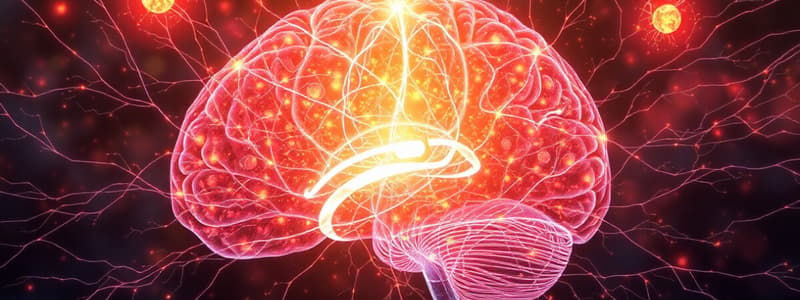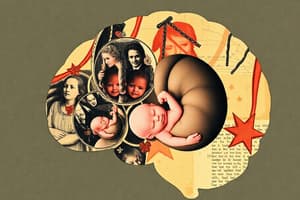Podcast
Questions and Answers
Which embryonic territory becomes the neocortex?
Which embryonic territory becomes the neocortex?
- Dorsal telencephalon (correct)
- Ventromedial midbrain
- Basal telencephalon
- Diencephalon
What is the main purpose of symmetric cell division during neurogenesis?
What is the main purpose of symmetric cell division during neurogenesis?
- To differentiate into specialized neurons
- To generate post-mitotic cells
- To expand the number of progenitor cells (correct)
- To create more glial cells
Which imaging technique measures the flow of blood to assess brain activity?
Which imaging technique measures the flow of blood to assess brain activity?
- PET
- MRI
- DTI
- fMRI (correct)
What part of the brain develops from the diencephalon?
What part of the brain develops from the diencephalon?
Which of the following terms refers to the refinement of neural connections after axon guidance?
Which of the following terms refers to the refinement of neural connections after axon guidance?
What structure is primarily responsible for the production of cerebrospinal fluid (CSF)?
What structure is primarily responsible for the production of cerebrospinal fluid (CSF)?
What is the role of the substantia nigra in relation to brain structures?
What is the role of the substantia nigra in relation to brain structures?
Which taste sensation is NOT one of the five primary tastants?
Which taste sensation is NOT one of the five primary tastants?
What type of channels mediates the salty and sour taste receptor cell depolarization?
What type of channels mediates the salty and sour taste receptor cell depolarization?
Which of the following neurotransmitters is primarily released from sour taste receptor cells?
Which of the following neurotransmitters is primarily released from sour taste receptor cells?
How often do taste receptor cells renew themselves?
How often do taste receptor cells renew themselves?
Which cranial nerves are involved in the central taste pathway?
Which cranial nerves are involved in the central taste pathway?
How do sweet, bitter, and umami tastants initiate signaling in taste receptor cells?
How do sweet, bitter, and umami tastants initiate signaling in taste receptor cells?
What type of cells primarily make mucus in the olfactory epithelium?
What type of cells primarily make mucus in the olfactory epithelium?
What is the role of the olfactory-specific G protein called Golf?
What is the role of the olfactory-specific G protein called Golf?
What structural feature identifies olfactory receptor cells as true neurons?
What structural feature identifies olfactory receptor cells as true neurons?
Flashcards are hidden until you start studying
Study Notes
Brain Development
- Basal Telencephalon develops into the basal ganglia: striatum and amygdala
- Dorsal Telencephalon develops into the neocortex
- Diencephalon develops into the thalamus and hypothalamus
- Midbrain includes structures like the substantia nigra, VTA, auditory and visual tecta (colliculi)
- Ventricles and the cerebral aqueduct are important structures within the brain.
- Neurogenesis occurs in the cortex, initially with symmetric cell division for progenitor cell expansion (radial glia), then asymmetric division to generate post-mitotic cells that migrate and differentiate
- Cortical Development happens in an inside-out pattern
- Final stages of brain development include: differentiation, axon guidance, synaptogenesis, target-dependent cell death, synaptic pruning
- Four Lobes: frontal, parietal, temporal, and occipital lobes
- Frontal Lobe contains areas like the prefrontal cortex, motor cortex, and sensorimotor cortex
Brain Structures and Function
- Thalamus and Hypothalamus are key structures in the forebrain
- Midbrain and Hindbrain are important for motor control and other functions
- Meninges, BBB, CSF, ventricles work together to protect and nourish the brain
- CSF flows in a specific direction
Imaging Techniques
- MRI is a structural/static imaging technique that provides information about the general brain structure.
- DTI is a structural/static technique that focuses on white matter.
- PET is a functional technique that uses 2-DG to measure metabolic function, which is directly related to electrical activity.
- fMRI is a functional technique that measures changes in blood flow, also related to electrical activity. It can be used to study differences between patient groups.
Chemical Senses
- Taste (Gustation):
- Five tastant categories: sweet, sour, salty, bitter, umami
- Tongue, palate, and nasal cavity all contribute to taste perception
- Taste buds contain taste receptor cells
- Taste receptor cells are not neurons, but contain microvilli which receive tastant stimuli.
- Taste transduction involves local depolarizing potentials, transmitter release, and stimulation of gustatory afferents.
- Serotonin is released for salty and sour, while ATP is released for sweet, bitter, and umami.
- Salty and sour taste receptor cells are depolarized by amiloride-sensitive Na+ channels and H+ channels, respectively.
- Sweet, bitter, and umami work via GPCRs, PLC, IP3, Ca2+ release, and Ca2+-activated Na+ channels.
- Bitter receptors are the most diverse, while sweet and umami receptors are more specific.
- Central taste pathway involves cranial nerves VII, IX, and X, the NST, thalamus, and gustatory cortex.
- Taste receptor cells have a 2-week turnover rate.
- Olfaction:
- Olfactory epithelium in the roof of the nasal cavity
- Olfactory receptor cells (OSNs) are true neurons, their axons form the primary sensory afferents (cranial nerve I)
- Olfactory bulb receives input from OSNs.
- Vomeronasal organ is mainly found in animals.
- Supporting cells create mucus.
- Basal cells are the progenitors of OSNs.
- Odorant transduction: odor receptors are GPCRs on cilia.
- Golf activates adenylyl cyclase to produce cAMP which opens cAMP-gated Na+ and Ca2+ channels and Cl- channels
- Olfactory receptor cells have a 4-8 week turnover rate.
Studying That Suits You
Use AI to generate personalized quizzes and flashcards to suit your learning preferences.




